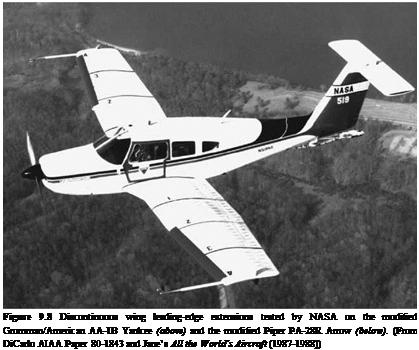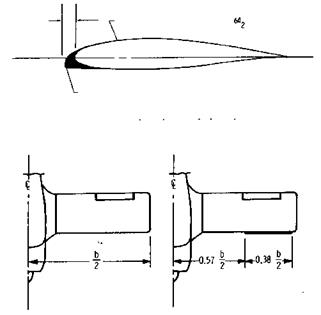Effects of Wing Design on Spin Entry and Recovery
Modified tail arrangements did not really accomplish much for the Yankee, and NASA turned its attention to modifications of the wing outer panel. In so doing, a line of research was reopened that had been followed at NACA by the versatile Fred E. Weick and Carl J. Wenzinger in the 1930s. There was also the work by R. A. Kroeger of the University of Michigan and T. W. Feistel of NASA Ames Research Center in 1975, in which the concept of a segmented or discontinuous wing leading edge was developed to control stall progression and minimize loss in roll damping at the stall. This type of wing leading edge had been seen previously on the McDonnell F-4 Phantom II.
The best NASA wing leading-edge extensions tested on general-aviation airplanes also have sharp discontinuities at their inboard ends (Figure 9.8). The sharp discontinuities evidently trigger vortices that slow the spread of inboard wing stalling to the outer wing panels.
 |
 For each installation, there appears to be an optimum location for the droop discontinuity, to delay spin entry and improve spin recovery. Full-span leading-edge droop was actually a detriment on the Yankee, causing easily entered flat spins where there had been none before.
For each installation, there appears to be an optimum location for the droop discontinuity, to delay spin entry and improve spin recovery. Full-span leading-edge droop was actually a detriment on the Yankee, causing easily entered flat spins where there had been none before.
The discontinuous outboard wing leading-edge droop modification provides generally good spin resistance and spin recovery characteristics on a number of different
|
Figure 9.9 Wing leading-edge droop tested by NASA on a 1/4-scale model of the DeVore Aviation trainer. The modification eliminates an abrupt, uncontrollable roll departure at the stall. (From Yip, Ross, and Robelen, Jour. of Aircraft, 1992) |
configurations. These include the modified Grumman/American AA-1B Yankee; the modified Piper T-Tail Arrow; and models of the Smith Aviation Trainer, the Questair Venture, and the DeVore Aviation Corporation Trainer, an ultralight pusher (Figure 9.9).












